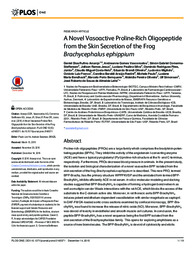A novel vasoactive proline-rich oligopeptide from the skin secretion of the frog Brachycephalus ephippium.
A novel vasoactive proline-rich oligopeptide from the skin secretion of the frog Brachycephalus ephippium.
Author(s): ARCANJO, D. D. R.; VASCONCELOS, A. G.; COMERMA-STEFFENSEN, S. G.; JESUS, J. R.; SILVA, L. P. da; PIRES JÚNIOR, O. R.; COSTA-NETO, C. M.; OLIVEIRA, E. B.; MIGLIOLO, L.; FRANCO, O. L.; RESTINI, C. B. A.; PAULO, M.; BENDHACK, L. M.; BEMQUERER, M. P.; OLIVEIRA, A. P.; SIMONSEN, U.; LEITE, J. R. de S. de A.
Summary: Proline-rich oligopeptides (PROs) are a large family which comprises the bradykinin-potentiating peptides (BPPs). They inhibit the activity of the angiotensin I-converting enzyme (ACE) and have a typical pyroglutamyl (Pyr)/proline-rich structure at the N- and C-terminus, respectively. Furthermore, PROs decrease blood pressure in animals. In the present study, the isolation and biological characterization of a novel vasoactive BPP isolated from the skin secretion of the frog Brachycephalus ephippium is described. This new PRO, termed BPP-Brachy, has the primary structure WPPPKVSP and the amidated form termed BPPBrachyNH2 inhibits efficiently ACE in rat serum. In silico molecular modeling and docking studies suggest that BPP-BrachyNH2 is capable of forming a hydrogen bond network as well as multiple van der Waals interactions with the rat ACE, which blocks the access of the substrate to the C-domain active site. Moreover, in rat thoracic aorta BPP-BrachyNH2 induces potent endothelium-dependent vasodilatation with similar magnitude as captopril. In DAF-FM DA-loaded aortic cross sections examined by confocal microscopy, BPP-BrachyNH2 was found to increase the release of nitric oxide (NO). Moreover, BPP-BrachyNH2 was devoid of toxicity in endothelial and smooth muscle cell cultures. In conclusion, the peptide BPP-BrachyNH2 has a novel sequence being the first BPP isolated from the skin secretion of the Brachycephalidae family. This opens for exploring amphibians as a source of new biomolecules. The BPP-BrachyNH2 is devoid of cytotoxicity and elicits endothelium-dependent vasodilatation mediated by NO. These findings open for the possibility of potential application of these peptides in the treatment of endothelial dysfunction and cardiovascular diseases.
Publication year: 2015
Types of publication: Journal article
Observation
Some of Embrapa's publications are published as ePub files. To read them, use or download one of the following free software options to your computer or mobile device. Android: Google Play Books; IOS: iBooks; Windows and Linux: Calibre.
Access other publications
Access the Agricultural Research Database (BDPA) to consult Embrapa's full library collection and records.
Visit Embrapa Bookstore to purchase books and other publications sold by Embrapa.

